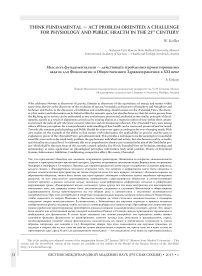Мыслить фундаментально - действовать проблемно-ориентированно: задача для физиологии и общественного здравоохранения в XXI веке
Автор: Кофлер В.В.
Журнал: Вестник Международной академии наук (Русская секция) @vestnik-rsias
Рубрика: Медико-биологические науки
Статья в выпуске: 1, 2013 года.
Бесплатный доступ
Тот, кто прославляет Ньютона как человека, открывщего гравитацию, Эйнштейна за открытие эквивалентности энергии и пространственновременной материи, Дарвина, открывшего эволюцию видов, Вернадского, открывшего биосферу и ноосферу и Сеченова и Павлова, как первооткрывателей комплексов и выработки условного рефлекса, должен связать с «Расширенным взглядом» открытие того, что материя и информация могут быть связанны в рамках семантического пространства, но также открытие того, что весь процесс, начиная с «большого взрыва» до образования общества, может быть понят как один процесс эволюции и объяснен одним подобным принципом развития, то есть результатом группирования, проведенного существующими объектами в соответствующий момент времени в рамках согласия между полюсами самореференции, референции согласия и референции окружающей среды. «Расширенный взгляд» использует среди других все эти виды восприятия для всестороннего понимания того, как здоровье может быть восстановлено, сохранено и улучшено.
Торможение, побуждение, возбуждение, условнорефлекторное обучение, рефлекс, зависимость
Короткий адрес: https://sciup.org/14315239
IDR: 14315239
Список литературы Мыслить фундаментально - действовать проблемно-ориентированно: задача для физиологии и общественного здравоохранения в XXI веке
- Anokhin P. K. The functional system as a unit of organism integrative activity. System Theory and Biology Proc. of the III Systems Ed. M.D. Mesarovic, Springer, Berlin, 1968.
- Ashford N.A., Miller C.S. Low-level chemical sensitivity: current perspectives//Int Arch Occup Environ Health 1996. (68): 367-376.
- Bateson G. Mind and Nature: A Necessary Unity (Advances in Systems Theory, Complexity, and the Human Sciences). Hampton Press. 1979.
- Belloc N.B., Breslow L. Relationship of Physical Health Status and Health Practices, Preventive Medicine 1972 (1): 409-421.
- Chivelev A., Kofler W., Glazachev O. Microscope, macroscope and multimedia -challenges for scientific journals//Herald of the International Academy of Science, Russian Section, 2012; Sp. Edition: рр. 53-57.
- Engel G.L. The need for a new medical model: A challenge for biomedicine, Science, 1977, (196) 4286, 129-136.
- Holmes T.H., Rahe R.H. The Social Readjustment Rating Scale//J Psychosom. Res. 1967: 11 (2): 213-218.
- Holton G. Einsteins Methode zur Theoriebildung//Aichenburg P.C & R.U. Sexl (eds): Albert Einstein: Sein Einfluss auf Physik, Philosophie und Politik, Vieweg, Braunschweig 1979.
- Kant I. Kritik der reinen Vernunft, Vorrede 2. Auflage, 1787, AA III, 11-13.
- Kofler W. Toxicopy -A basic mechanism to cope with environmental threats//Seemayer NH, Hadnagy W, Eds. Environmental Hygiene. Berlin: Springer, 1988, 168-174.
- Kofler W., Wongphanich M. AustrianThai Toxicopy Project: Aims of the project and report of working situation. In: Kofler W, Wongphanich M, (Eds.) Toxicopy. Bangkok: Occupational Health Department Mahidol University, 1988.
- Kofler W.W. Toxicopy mechanism, complex evolutionary coping and the need for new types of conditions for emittents. In: Air and Waste Management Association. Health and Ecological Effects, in: Papers from the 9th World Clean Air Congress, Montreal, Health and Ecological effects, AWMA. Pittsburgh, 1992: IU-21A-01.
- Kofler W. Umweltängste, ToxikopieMechanismus, komplexes evolutionäres CopingModell und die Notwendigkeit neuartiger Auflagen für genehmi-gungspflichtige Anlagen. In: Aurand K, Hazard BP, Tretter F, Hrsg. Umweltbelastungen und Ängste -Erkennen, Bewerten, Vermeiden. Opladen: Westdeutscher Verlag, 1993: 225-267..
- Kofler W. Health effects of environmental disasters and the need of a more complex model of man. In: Y. Steinberger, Ed. Preservation of our world in the wake of change, 1996,. Jerusalem: ISEEQS Pub., 1996; VI A/B: 275-282.
- Кofler W. Toxicopy-mechanism, the theory of complex evolutionary coping and risk as an interactive process between environment and person. In: Sugahara TS et al, (eds.) Health Risk Perspectives and Research. Kyoto: Health Research Foundation, 1993: 231-234.
- Kofler W., Gray G. A computer based informationsystem for the population: The example of the Glass Plant in Treibach. In: Proceedings of the 7th IUAPPA Regional Conference on Air Pollution and Waste Issues, November 2-4, 1994, Taipei, Volume I: 95-104.
- Kofler W., Wagner M., Paduch M., Mannebeck H. On combinatory effects of subjective stimulants and physical and chemical loads, Int. Union of Air Pollution and Environmental Protection Associations (ed.) The interface between developing and developed Countries, -NACA, Parklands, 1998; 2: 7G2
- Kofler W. Umweltmedizinisches Gutachten in Verwaltungsverfahren In: Janauer GA, Kerschner F, Oberleitner F. (Hrsg.). Der Sachverständige in Umweltverfahren. Wien: Manz, 1999: 152-215.
- Kofler W., Lercher P, Puritscher M. The need for sufficiently taking into account unspecific effects in the understanding of health risks, Part 1, 2 and 3: 12th World Clean Air and Environment Conference, Seoul, 2001.
- Kofler W. A comprehensive model of humans as social beings and the health relevance of their interactions with and expectations on their environment, Th. Kuhn Honor Lecture 2004, 13th World Clean Air and Environment Congress, IUAPPA, London, 2004.
- Kofler W. The relevance of Sechenov for the development of the theory of an «Extended view» of a human person as a social being, Russian Acad. Science, Russian Academy of Medical Sciences (eds.) Sechenov Honor Lectures 2004, Moscow, 3-68, 2005.
- Kofler W. Think fundamental -act problem oriented: A challenge for Physiology and Public Health in the 21st century, PowerPoint version English/Russian, Inauguration lecture. -Moscow, 25.1.2013
- Kuhn Th. The structure of scientific revolution. -Chicago, 1962.
- Popper K.R. Logic of Scientific Discovery, 10. Auflage, Mohr (Paul Siebeck), Tübingen, 1994.
- Schilpp P.A. Albert Einstein -philosopher-scientist, The library of living philosophers, VII, La Solla, 1949.


